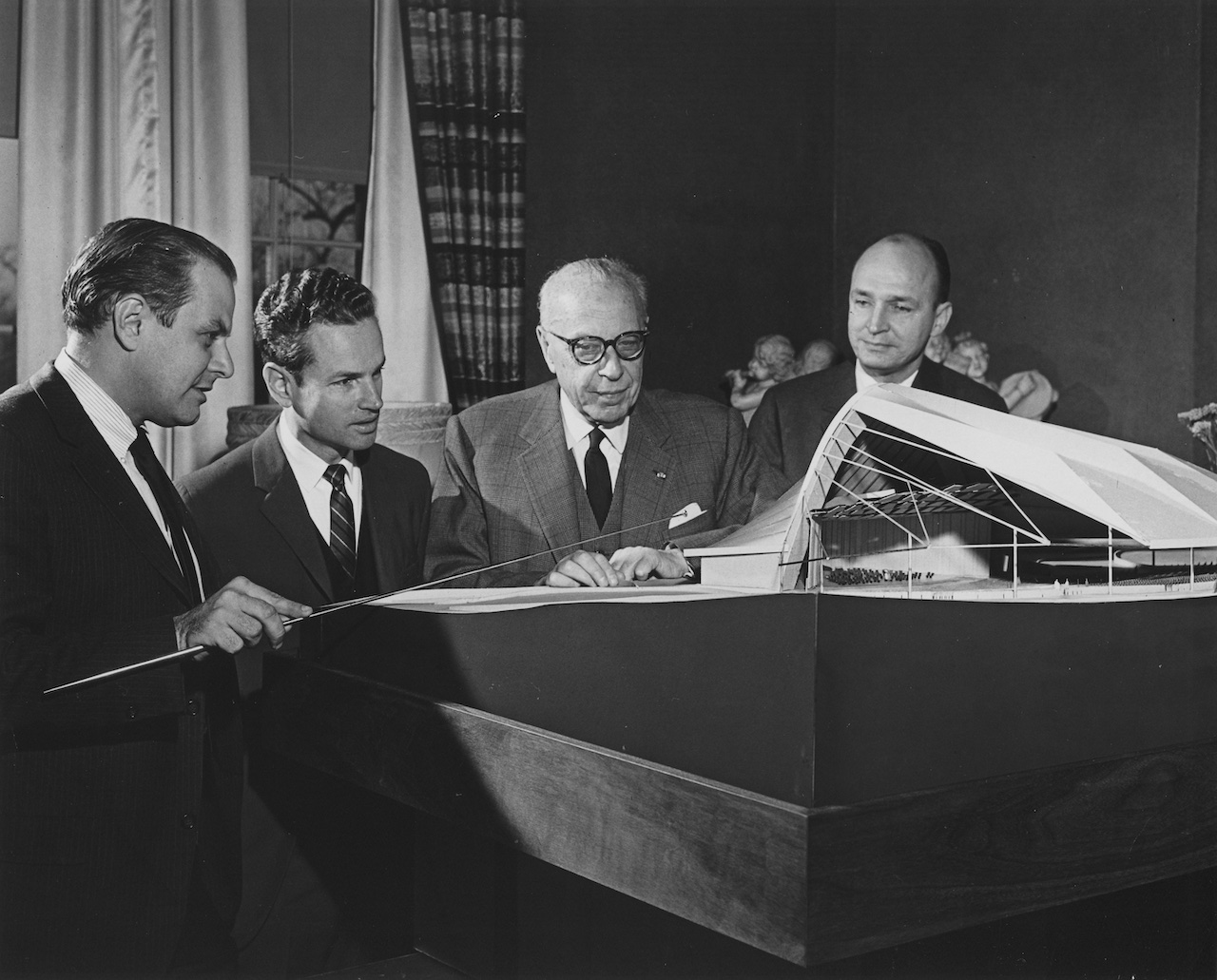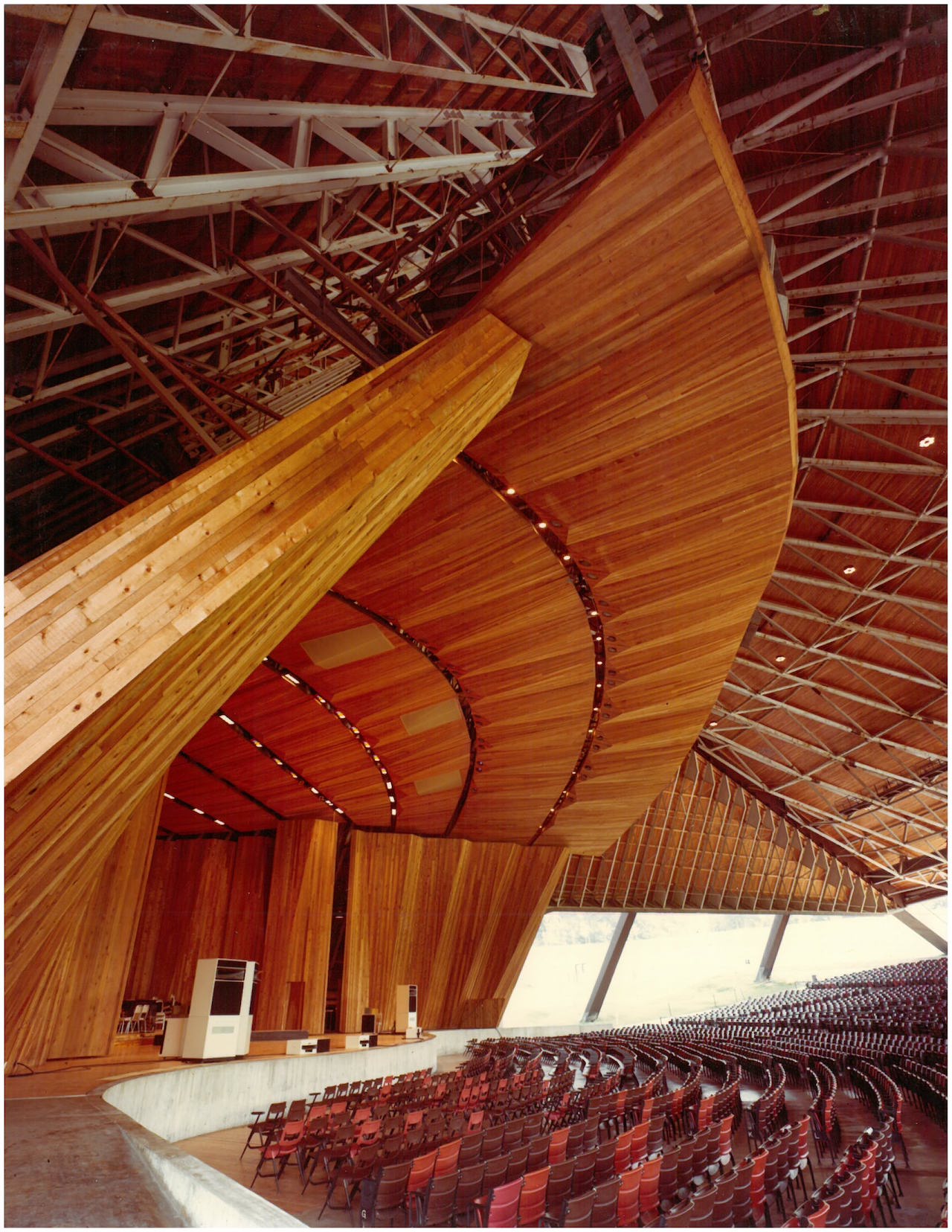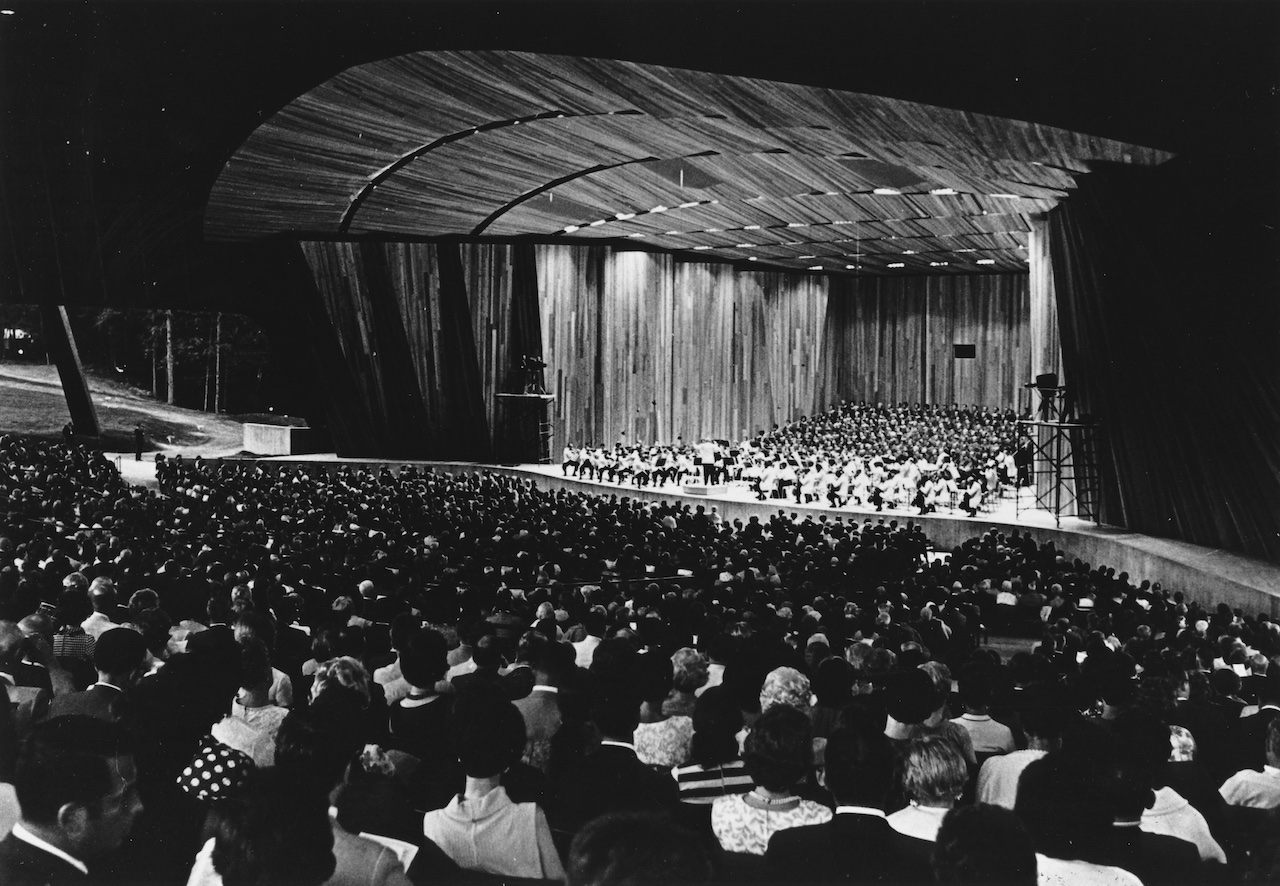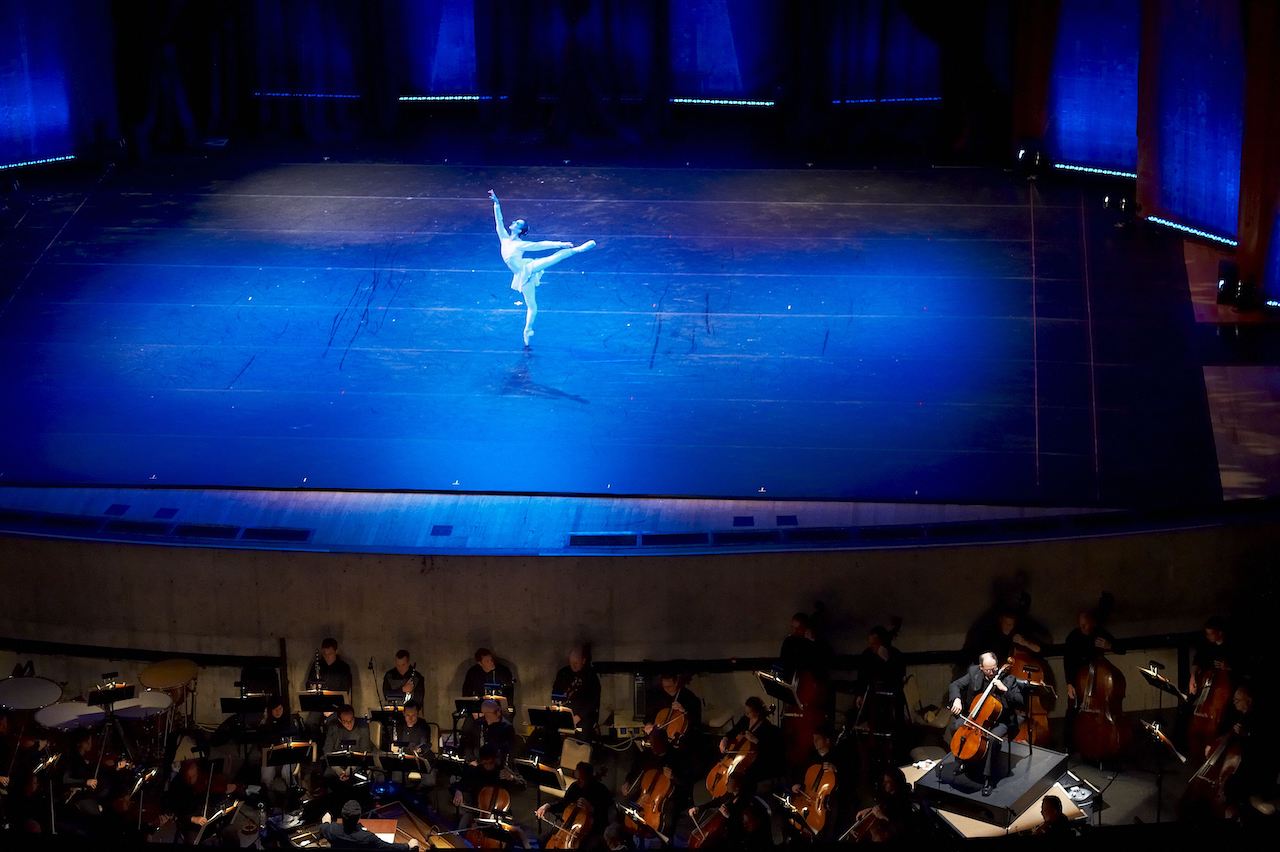
Blossom Music Center
Over 50 Years of Summer Entertainment
For over fifty years, Blossom Music Center has come alive with music and other performing arts during the summer in Cuyahoga Falls, Ohio — just south of Cleveland and the home of The Cleveland Orchestra. Blossom’s repertoire varies widely, featuring popular orchestral favorites, jazz and Broadway tunes, rock and country stars, and multimedia events such as live movie concerts. Young artists may also receive training during the summer nearby in Kent, Ohio, through the Kent Blossom Music Festival: a partnership between Kent State University and The Cleveland Orchestra. Millions of people have visited Blossom since its opening in 1968, but what sparked its creation?

The Cleveland Orchestra ranks highly among the leading orchestras in the United States, but for decades after its debut in 1918, the Orchestra lacked a summer season and a summer home, even after other major ensembles established their summer presence. As early as 1923, the Orchestra’s founder, Adella Prentiss Hughes, is on record asking for a summer season to help give the musicians the pay they deserve. Before Blossom, ensemble members typically played a 30-something week season at one wage plus a separate summer contract at a lower rate. Former music director Erich Leinsdorf also asked Orchestra trustees to develop a year-long contract in 1943, noting that “only through permanence can music develop from a fine entertainment to become part of our spiritual life.” Unfortunately, contracts remained uneven throughout the next few years due to World War II and its resulting staffing and financial challenges. Upon music director George Szell’s arrival, he consistently took up the call for a year-long contract for his musicians; he cultivated a highly precise, unified sound that would benefit from consistent employment for his valued musicians.
Finally, by 1964, it seemed that year-long employment and a summer home for The Cleveland Orchestra could become a reality. The Board of Trustees — following advice from Szell, the musicians and their union, and the actions of the other major orchestras in the United States — voted to move forward in establishing a dedicated summer performance venue. In 1964, a few trustees visited the summer homes of other “Big Five” institutions for inspiration and research. With a clearer idea of the must-haves of the potential summer venue, the Board hired William H. Gould’s engineering firm to help select the perfect location. After an exhaustive search of over eighty sites from late 1964 to May 1966, Gould and the Board decided on a choice piece of land in Northampton Township (now subsumed into Cuyahoga Falls), which would allow music lovers from Columbus, Pittsburgh, and Akron to attend — not only Clevelanders. The location was perfect due to its natural bowl shape, which allows for unobstructed views from many seats, proximity to larger populations and transit, and climate.

After the site selection in 1966, the Board and the skilled team they hired moved quickly to start designing the building. The Musical Arts Association enlisted the architecture firm of Schafer, Flynn & Van Dijk, with Peter Van Dijk acting as chief architect and Pietro Belluschi joining later as the architectural advisor. Acoustician Christopher Jaffe worked on the original designs for perfecting the acoustic needs of Blossom, and Heinz Keilholz (the designer behind Severance’s “Szell Shell”) succeeded him in 1967. Before the Turner Construction Company could break ground, however, the Orchestra needed to secure a massive amount of funding. Part of this financial support came from the Ford Foundation’s $2 million grant, given with the provision that the Musical Arts Association must attain more funding within the next five years. The Half-Century Fund campaign, spearheaded by Trustee Walter K. Bailey and Board president Frank E. Joseph, met this goal and secured continued funding for Blossom. A large portion of the original fundraising came from the Dudley S. Blossom family — the namesake of the summer home — who donated $1.335 million for the venue.
Dudley S. Blossom, Sr. and his wife, Elizabeth Bingham Blossom, supported the Orchestra from its inception until their passing, with Dudley, Sr. leading the fundraising efforts to build Severance Hall. Dudley S. Blossom, Jr. and his wife, Emily Blossom, continued this tradition by giving generously but often anonymously. Upon hearing the Board voted to name the summer home “Blossom Music Center,” Emily Blossom wrote, “During the past five years I have dreamed of a lasting memorial that would encompass many of the thigs that Dud and his father believed in, worked so hard for, and loved. ‘Blossom Music Center’ is the perfect answer.” Fortunately, many members of the generous Blossom family could attend groundbreaking ceremonies at the future site of Blossom on July 2, 1967. Elizabeth Blossom and her youngest granddaughter, Betsy, ceremoniously dug the first shovels of dirt. Emily proclaimed, “There is music in our hearts today; there’ll be music in the air a year from now.” Against many doubters’ expectations, Emily was right.

Blossom Music Center is situated on over 500 acres of land, allowing for a large stage and seating in-house or on the Lawn for nearly 20,000 attendees after its renovation in 2003. Van Dijk’s design for the Pavilion earned a 1969 Architectural Award for Excellence and continues to impress. Instead of interior supporting columns, which may obstruct views or distort sound, the Pavilion relies on a web of tubular steel pipe trusses anchored into concrete. The massive width of the stage and the angle of the side walls allow for unobstructed views from any seat and on the Lawn. The shell’s design includes moving parts to allow for staged performances, and the pit used for these productions can be covered when not in use to allow for extra seating near the stage. Little to no amplification is necessary during orchestral concerts due to the design team’s spectacular acoustic construction, but speakers pepper the Pavilion and Lawn, mainly for rock and pop concerts. To prevent an echo when amplification is needed, the playback system operates on a slight delay to mediate the different speeds of sound and electricity. The builders and designers considered acoustics and sightlines at every turn, and their attention to detail undoubtedly contributed to the success of Blossom.

Construction workers put in overtime to finish the Blossom Pavilion by the opening concert on July 19, 1968. Local press noted that people inside and outside the Blossom building efforts were jokingly taking bets about whether they could finish construction time. Thanks to an incredible amount of hard work from designers, construction professionals, and fundraisers, the Pavilion was indeed ready for opening day. Some landscaping still needed to be done, and the road leading to the Center needed to be widened, among other things. However, just over one year after breaking ground, Blossom Music Center was ready for audiences.

Blossom Music Center’s opening night consisted of dedicatory remarks and an all-Beethoven program under the baton of George Szell, following a rendition of “The Star-Spangled Banner.” Szell and critics alike were thrilled with Blossom’s construction, acoustics, and atmosphere. One critic called it “an oasis of music and beauty,” and another noted how it could “blend the richness of nature with the richness of classical sounds.” Szell’s only main complaints were the lack of air-conditioning for the stage and a powerful metallic booming sound (the “Blossom Boom”) that occurred when the Pavilion’s steel structure expanded or contracted after temperature changes. Fortunately, designers and builders speedily resolved both issues by 1970.
Blossom quickly became a Northeast Ohio staple, and its programming grew in number and scope. The Blossom Festival Band debuted for the first July 4th celebration concert in 1969 under the baton of famed composer Meredith Willson. Leonard B. Smith began leading the band every year in 1972 until Loras John Schissel took over in 1998 – a collaboration that continues to this day. The Blossom Festival Chorus debuted during Blossom’s opening season in August of 1968 and continues to perform with a wide variety of artists each summer. Audiences can attend live theater nearby at the Porthouse Theatre, another collaboration of Blossom and Kent State University. Additionally, operas occasionally graced the stage at Blossom, and touring ballet companies would also make appearances, including the New York City Ballet, Joffrey Ballet, and Houston Ballet. From the beginning, Blossom brought in popular music stars beyond the orchestral world; the first two seasons saw major household-name performers, such as Indian composer and sitarist Ravi Shankar, jazz legend Louis Armstrong and his Allstars, and the rock band Blood, Sweat & Tears. With the addition of live movie concerts and an eventual collaboration with LiveNation to book even more contemporary popular artists, Blossom Music Center manages to attract an incredibly diverse audience.

Blossom Music Center’s award-winning steel structure symbolizes summer music in Northeast Ohio. Attendees can bring picnic lunches or purchase from a restaurant on the grounds, stroll through the gardens, and experience a wide array of live performances. The Cleveland Orchestra musicians continue to receive a well-deserved year-long contract made possible by Blossom’s inception. Once called a “challenger to Tanglewood” in the press, Blossom has become a summer home esteemed beyond original expectations, worthy of its own place in the legacy of cultural institutions.